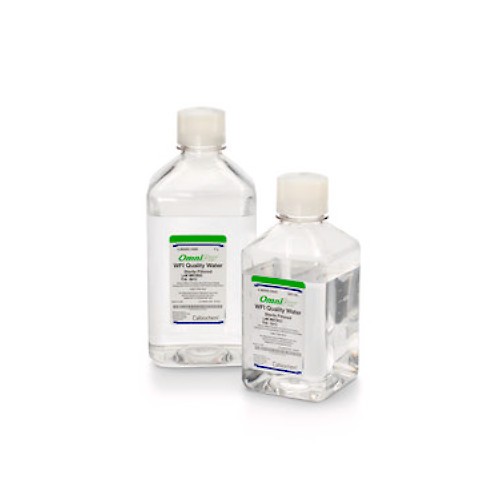
OmniPur Water, WFI Quality, Sterile Purified Water, Cell Culture Tested – CAS7732-18-5, 1L
RM152.00Brand:
Merck
** This product has been discontinued.
OmniPur Water is sterile water that is tested to be DNase free, Protease free, RNase free and bacterial free.
It is suitable to be used in:
- Cell Biology
- Cell culture media preparation, extraction buffer, Molecular work, reconstitute of compound
- Diluent for live cells staining
- Sterile solution preparation Microbiology Sample Preparation
- Diluent and rinsing reagent in Microbial Membrane Filtration
Key Specification:
- Sterile by USP Standard
- DNase, RNase, Protease-Free
- < 500 ppb Total Organic Carbon
- < 0.025 EU/ml Bacterial Endotoxin
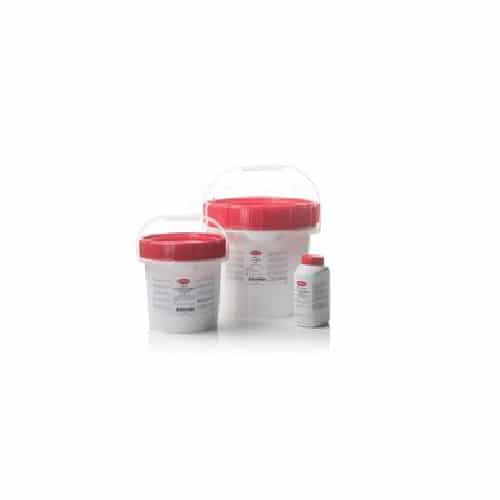
One Broth Base – Listeria 500g
RM936.00Brand:
Thermo ScientificTM OxoidTM
Detect and enumerate Escherichia coli and other coliforms in food and water samples with selective, chromogenic Thermo Scientific™ Brilliance™ E. coli / Coliform Selective Agar. The agar base uses two chromogens to differentiate between E. coli and other coliforms. This results in purple E. coli, as they are able to cleave both chromogens while other coliforms, giving pink colonies.
ONE Broth-Listeria Base, Oxoid Composition
| Typical Formula* | gm/litre |
| Peptone | 28.0 |
| Carbohydrate mix | 6.0 |
| Salt mix | 10.0 |
| Final pH 7.4 ± 0.2 @ 25°C |
ONE Broth-Listeria, Oxoid Preparation:
Suspend 22g of ONE Broth-Listeria Base in 500ml (44g/l) of distilled water. Mix well and sterilize by autoclaving at 121°C for 15 minutes. Cool the medium to below 50°C and aseptically add the contents of one vial of ONE Broth-Listeria Selective Supplement (SR0234) reconstituted as directed.
Storage conditions and Shelf life
ONE Broth-Listeria Base must be stored tightly capped in the original container at 10-30°C.
Store the prepared medium for up to 4 weeks at 2-8°C.
Precautions
ONE Broth-Listeria Base and ONE Broth Selective Supplement are for Laboratory Use Only.
ONE Broth-Listeria Base is designated as “Irritant” and ONE Broth-Listeria Selective Supplement is designated as “Harmful”. For a full Material Safety Data Sheet (MSDS).
Do not use ONE Broth-Listeria Base or ONE Broth-Listeria Selective Supplement beyond the stated expiry dates, or if the products show any sign of deterioration.
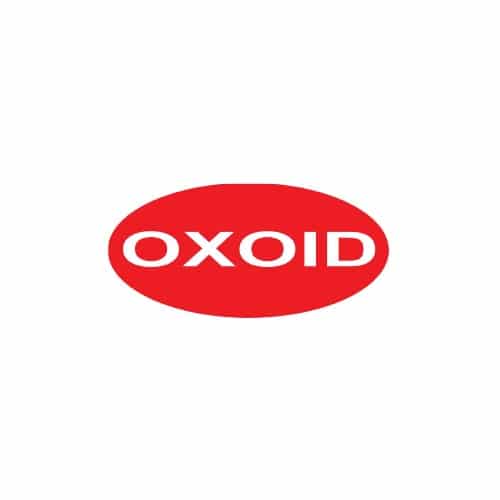
ONE Broth Salmonella Selective Supplement 10X2.25L
RM0.00Brand:
Thermo ScientificTM OxoidTM
Thermo Scientific™ Oxoid ONE Broth Salmonella Selective Supplement is a selective supplement for use with ONE Broth-Salmonella Base.
ONE Broth Salmonella Selective Supplement, Oxoid Composition
| Vial Contents (each vial is sufficient for 500ml of medium) | per vial | per litre |
| Novobiocin | 2.7mg | 12mg |
ONE Broth Salmonella Selective Medium Preparation:
Suspend 5.6g of ONE Broth-Salmonella Base in 225ml of distilled water. Sterilize by autoclaving at 121°C for 15 minutes. Cool to below 50°C and add the contents of 1 vial of ONE Broth-Salmonella Supplement (SR0242), resuspended as directed.
Storage conditions and Shelf life
The ONE Broth-Salmonella Selective Supplement should be stored in the dark at 2-8ºC. When stored as directed, the unopened products will remain stable until the expiry date printed on the packaging.
Once prepared, ONE Broth-Salmonella can be stored for up to 2 weeks when made from CM1091 and SR0242 according to the manufacturer’s instructions and stored at 2-8ºC, in the dark. A longer shelf life may be attainable, but should be validated under the relevant, local manufacturing and storage conditions.

One Broth-Listeria Selective Supplement
RM0.00Brand:
Thermo ScientificTM OxoidTM
The Oxoid ONE Broth-Listeria is for the selective enrichment broth for Listeria species from food samples in 24 hours.
One Broth-Listeria Selective Supplement
ONE Broth-Listeria is the selective enrichment broth used in the Oxoid Listeria Precis™ rapid culture method. For information simply download the ONE Broth-Listeria data sheet (273KB) or the Listeria Precis data sheet (680KB) in PDF format.
ONE Broth-Listeria, Oxoid Preparation:
Suspend 22g of ONE Broth-Listeria Base in 500ml (44g/l) of distilled water. Mix well and sterilize by autoclaving at 121°C for 15 minutes. Cool the medium to below 50°C and aseptically add the contents of one vial of ONE Broth-Listeria Selective Supplement (SR0234) reconstituted as directed.
Storage conditions and Shelf life
ONE Broth-Listeria Selective Supplement should be stored in the dark at 2-8°C.
Store the prepared medium for up to 4 weeks at 2-8°C.
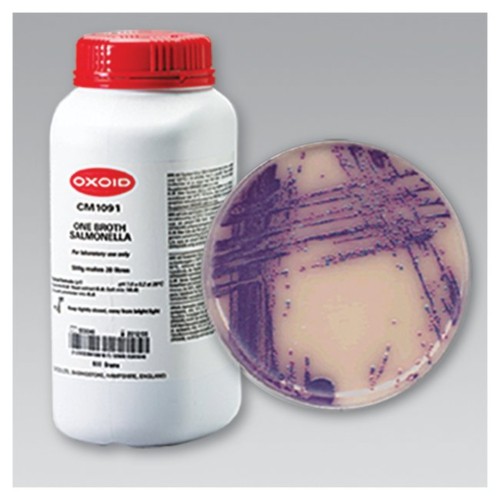
One Broth-Salmonella 500g
RM3,002.00Brand:
Thermo ScientificTM OxoidTM
Enrich and recover Salmonella spp. from food samples in a single step with Thermo Scientific™ Oxoid™ ONE Broth-Salmonella Base, when prepared with Thermo Scientific Oxoid ONE Broth-Salmonella Selective Supplement (SR0242).
ONE Broth-Salmonella Base, Oxoid Composition
| Typical Formula* | gm/ litre |
| Peptone | 5 |
| Yeast extract | 5 |
| Salt buffer mix | 10 |
| Growth promoter mix | 5 |
| pH 7.0† ± 0.2 at 25ºC |
ONE Broth-Salmonella Base, Oxoid Preparation:
Suspend 5.6g of ONE Broth-Salmonella Base in 225ml of distilled water. Sterilize by autoclaving at 121°C for 15 minutes. Cool to below 50°C and add the contents of 1 vial of ONE Broth-Salmonella Supplement (SR0242), resuspended as directed.
Storage conditions and Shelf life
ONE Broth-Salmonella should be stored tightly capped in the original container at 10-30ºC. When stored as directed, the unopened products will remain stable until the expiry date printed on the packaging.
Once prepared, ONE Broth-Salmonella can be stored for up to 2 weeks when made from CM1091 and SR0242 according to the manufacturer’s instructions and stored at 2-8ºC, in the dark. A longer shelf life may be attainable, but should be validated under the relevant, local manufacturing and storage conditions.
Precautions
ONE Broth-Salmonella medium and Brilliance Salmonella Agar are for in vitro diagnostic use only, by experienced microbiologists. It must not be used beyond the stated expiry date, or if the product shows any sign of deterioration. Sterilize specimens, equipment and media properly after use; dispose waste in accordance with local rules and regulations. Directions should be read and followed carefully.

One Broth-Salmonella Supplement 10x225ML
RM176.00Brand:
Thermo ScientificTM OxoidTM
Thermo Scientific™ Oxoid™ ONE Broth-Salmonella Supplement is for the selective enrichment of Salmonella spp. from food samples in 24 hours in a single enrichment step.
- Add to ONE Broth-Salmonella Part No. CM1091B
- Each vial supplements 500mL of medium
ONE Broth Salmonella Selective Supplement, Oxoid Composition
| Vial Contents (each vial is sufficient for 500ml of medium) | per vial | per litre |
| Novobiocin | 2.7mg | 12mg |
ONE Broth Salmonella Selective Medium Preparation:
Suspend 5.6g of ONE Broth-Salmonella Base in 225ml of distilled water. Sterilize by autoclaving at 121°C for 15 minutes. Cool to below 50°C and add the contents of 1 vial of ONE Broth-Salmonella Supplement (SR0242), resuspended as directed.
Storage conditions and Shelf life
The ONE Broth-Salmonella Selective Supplement should be stored in the dark at 2-8ºC. When stored as directed, the unopened products will remain stable until the expiry date printed on the packaging.
Once prepared, ONE Broth-Salmonella can be stored for up to 2 weeks when made from CM1091 and SR0242 according to the manufacturer’s instructions and stored at 2-8ºC, in the dark. A longer shelf life may be attainable, but should be validated under the relevant, local manufacturing and storage conditions.
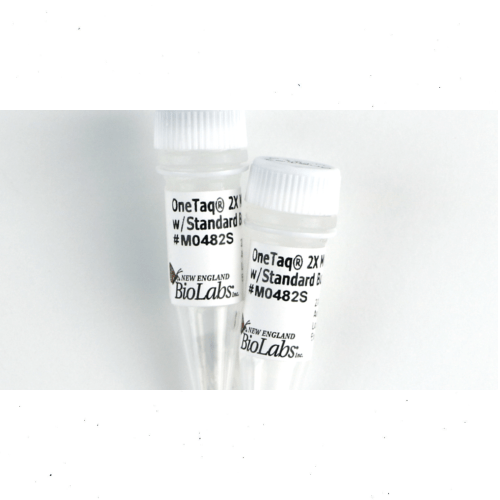
OneTaq 2X Master Mix with Standard Buffer
Brand:
New England Biolabs
OneTaq® DNA Polymerase is an optimized blend of Taq and Deep Vent™ DNA polymerases for use with routine and difficult PCR experiments.
- Obtain high yields across a wide range of AT / GC content
- 2X higher fidelity than Taq
- Master mix is a 2X concentrated solution containing everything needed for robust amplification
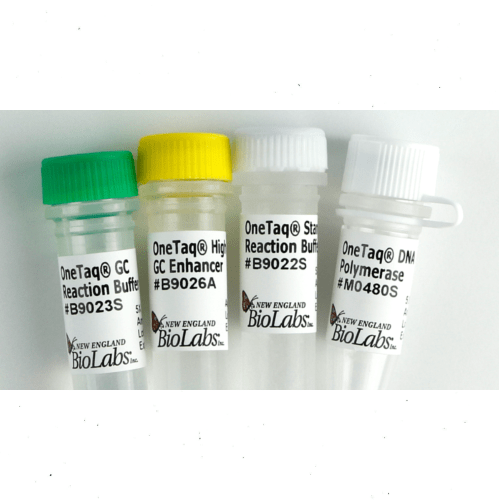
OneTaq DNA Polymerase
Brand:
New England Biolabs
The ONE polymerase for your endpoint PCR needs. OneTaq DNA Polymerase is an optimized blend of Taq and Deep Vent® DNA polymerases for use with routine and difficult PCR experiments.
- 2X higher fidelity than Taq
- Ideal for routine, AT- or GC-rich templates
- Hot start and master mix versions available

OneTaq Hot Start 2X Master Mix with GC Buffer
Brand:
New England Biolabs
OneTaq® DNA Polymerase is an optimized blend of Taq and Deep Vent™ DNA polymerases for use with routine and difficult PCR experiments.
- Unique hot start formulation eliminates nonspecific amplification and does not require a separate activation step
- Obtain high yields with GC rich templates (>65%)
- Master mix is a 2X concentrated solution containing everything needed for robust amplification

OneTaq Hot Start 2X Master Mix with Standard Buffer
Brand:
New England Biolabs
OneTaq® DNA Polymerase is an optimized blend of Taq and Deep Vent™ DNA polymerases for use with routine and difficult PCR experiments.
- Obtain high yields across a wide range of AT / GC content
- 2X higher fidelity than Taq
- Hot Start feature enables room temperature reaction setup
- Master mix is a 2X concentrated solution containing everything needed for robust amplification

OneTaq Hot Start DNA Polymerase
Brand:
New England Biolabs
The ONE polymerase for your endpoint PCR needs
OneTaq DNA Polymerase is an optimized blend of Taq and Deep Vent™ DNA polymerases for use with routine and difficult PCR experiments.
- Unique hot start formulation eliminates non-specific amplification and does not require a separate activation step
- Robust yield with minimal optimization
- Ideal for routine, AT- or GC-rich templates
- Room temperature reaction setup
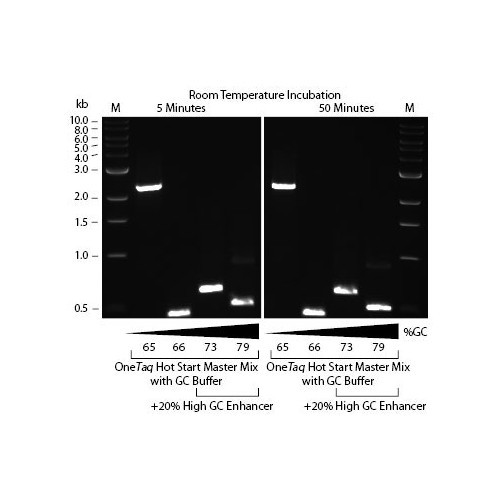
OneTaq Hot Start Quick-Load 2X Master Mix with GC Buffer
Brand:
New England Biolabs
OneTaq DNA Polymerase is an optimized blend of Taq and Deep VentR™ DNA polymerases for use with routine and difficult PCR experiments.
• Unique hot start formulation eliminates nonspecific amplification and does not require a separate activation step
• Obtain high yields with GC rich templates (>65%)
• Offered with inert tracking dyes for easy and direct loading of PCR products onto gels

OneTaq Hot Start Quick-Load 2X Master Mix with Standard Buffer
Brand:
New England Biolabs
The ONE polymerase for your endpoint PCR needs
OneTaq DNA Polymerase is an optimized blend of Taq and Deep Vent™ DNA polymerases for use with routine and difficult PCR experiments.
- Unique hot start formulation eliminates nonspecific amplification and does not require a separate activation step
- Obtain high yields across a wide range of AT / GC content
- Offered with inert tracking dyes for easy and direct loading of PCR products onto gels

OneTaq One-Step RT-PCR Kit – 30 rxns
RM0.00Brand:
New England Biolabs
Easy and efficient One-Step RT-PCR
- Optimized reaction mix for cDNA synthesis and PCR amplification in one step
- Hot start formulation eliminates nonspecific amplification and does not require a separate activation step
- Offered with Quick-Load® dyes for sample tracking and direct loading of PCR products onto gels

OneTaq Quick-Load 2X Master Mix with Standard Buffer
Brand:
New England Biolabs
The ONE polymerase for your endpoint PCR needs
OneTaq DNA Polymerase is an optimized blend of Taq and Deep Vent® DNA polymerases for use with routine and difficult PCR experiments.
- Obtain high yields across a wide range of AT- and GC- content
- 2X higher fidelity than Taq
- Master mix format contains inert tracking dye for easy and direct loading of PCR products onto gels

OneTaq Quick-Load DNA Polymerase
Brand:
New England Biolabs
Limited-time promotion! Buy M0509Sx5 (5 tubes of OneTaq Quick-Load DNA Polymerase, 100 units) for RM500 only! Before 13th November 2020!
OneTaq DNA Polymerase is an optimized blend of Taq and Deep Vent™ DNA polymerases for use with routine and difficult PCR experiments.
- Includes green Quick-Load reaction buffer for easy and direct loading of PCR products onto gels
- 2X higher fidelity than Taq
- Compatible with standard Taq protocols

OneTaq® RT-PCR Kit
RM0.00Brand:
New England Biolabs
Easy and efficient two-step RT-PCR
- Optimized reaction mixes for cDNA synthesis and PCR amplification
- Hot start formulation eliminates nonspecific amplification and does not require a separate activation step
- OneTaq® DNA Polymerase delivers robust amplification across a wide range of templates

Orange Serum Agar 500g
RM830.00Brand:
Thermo ScientificTM OxoidTM
Isolate and enumerate spoilage organisms of citrus products with Thermo Scientific™ Oxoid™ Orange Serum Agar (Dehydrated). Orange Serum Agar is developed specifically for the isolation and enumeration of microorganisms that are capable of surviving citrus products. The low pH of these products limits the growth of microorganisms to those capable of tolerating the acidic environment.
Orange Serum Agar, Oxoid Composition
| Typical Formula* | gm/litre |
| Tryptone | 10.0 |
| Yeast extract | 3.0 |
| Orange serum (equivalent solids) | 3.5 |
| Glucose | 4.0 |
| Di-potassium phosphate | 2.5 |
| Agar | 14.0 |
| pH 5.5 ± 0.2 @ 25°C |
Orange Serum Agar, Oxoid Preparation:
Suspend 37g in 1 litre of distilled water and bring gently to the boil to dissolve completely. Dispense into final containers and sterilise by autoclaving at 121°C for 15 minutes.
Storage conditions and Shelf life
Store the dehydrated medium at 10-30°C and use before the expiry date on the label.
Store the prepared medium at 2-8°C.
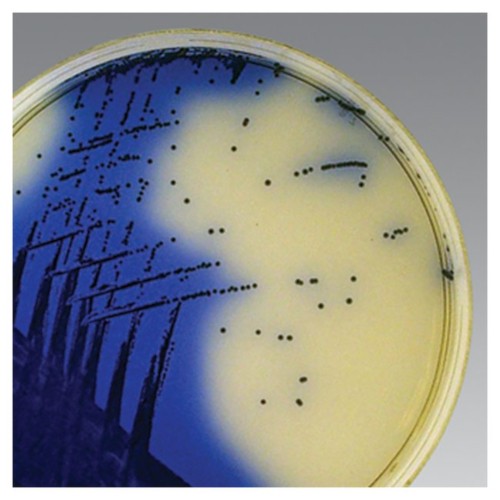
ORSAB Selective Supplement
RM0.00Brand:
Thermo ScientificTM OxoidTM
This product has been discontinued. Please contact us for more information.
Oxoid ORSAB Selective Supplement (Oxacillin Resistance Screening Agar Base Selective Supplement) is added to Oxacillin Resistance Screening Agar Base, Part No. CM1008B.
- Add to Oxacillin Resistance Screening Agar Base, Part No. CM1008B
- Each vial supplements 500mL of medium
ORSAB Selective Supplement, Oxoid Composition
| Vial contents (each vial is sufficient for 500ml of medium) | per vial | per litre |
| Polymyxin B | 25,000IU | 50,000IU |
| Oxacillin | 1.0mg | 2.0mg |
ORSAB Selective Medium Preparation:
Suspend 51.75g of Oxacillin Resistance Screening Agar Base in 500ml of distilled water and bring gently to the boil to dissolve. Sterilise by autoclaving at 121°C for 15 minutes. Cool to 50°C and aseptically add the contents of one vial of ORSAB Selective Supplement SR0195, reconstituted as directed below. Mix well and pour into sterile Petri dishes.
Storage conditions and Shelf life
ORSAB Selective Supplement should be stored at 2-8°C.
Store the prepared medium at 2-8°C.
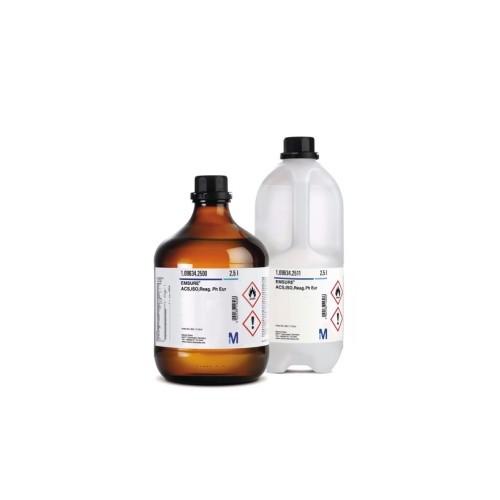
ortho-Phosphoric acid 85% for analysis EMSURE® ACS,ISO,Reag. Ph Eur (Merck)
Price range: RM175.00 through RM348.00Brand:
Merck
Description
CAS number: 7664-38-2
Chemical Formula: –
Molar Mass: –
Synonyms: o-Phosphoric acid, Orthophosphoric acid
EMSURE® grade solvents are suitable for a broad spectrum of classical lab applications and are frequently used in regulated and highly demanding lab applications. EMSURE® provides worldwide best and most extensive product specifications. We declare our EMSURE® range to be in compliance with the ACS, with the reagent part of the European Pharmacopoeia (Reag. Ph Eur) and also with the ISO standards.
Product Specification and MSDS for ortho-Phosphoric acid 85% EMSURE® (Merck).

Ot30 Oxytetracycline
RM84.00Brand:
Thermo ScientificTM OxoidTM

Ox1 Oxacillin
RM76.00Brand:
Thermo ScientificTM OxoidTM

Ox5 Oxacillin
RM0.00Brand:
Thermo ScientificTM OxoidTM
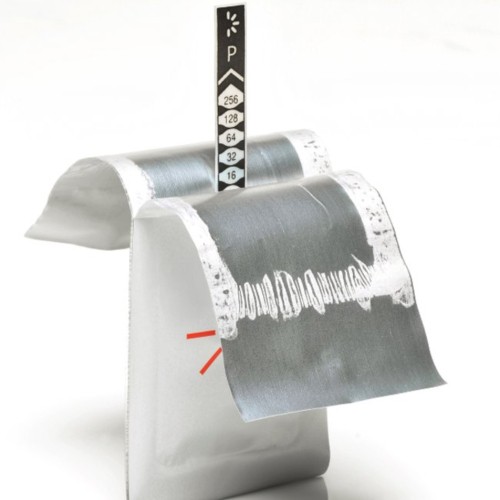
Oxacillin 256 M.I.C.E. (10 Pack)
RM0.00Brand:
Thermo ScientificTM OxoidTM
**This product is not available at the moment.
Effortlessly establish accurate Minimum Inhibitory Concentration (MIC) values manually using Thermo Scientific™ Oxoid™ Oxacillin M.I.C.Evaluator Strips (M.I.C.E.™).




